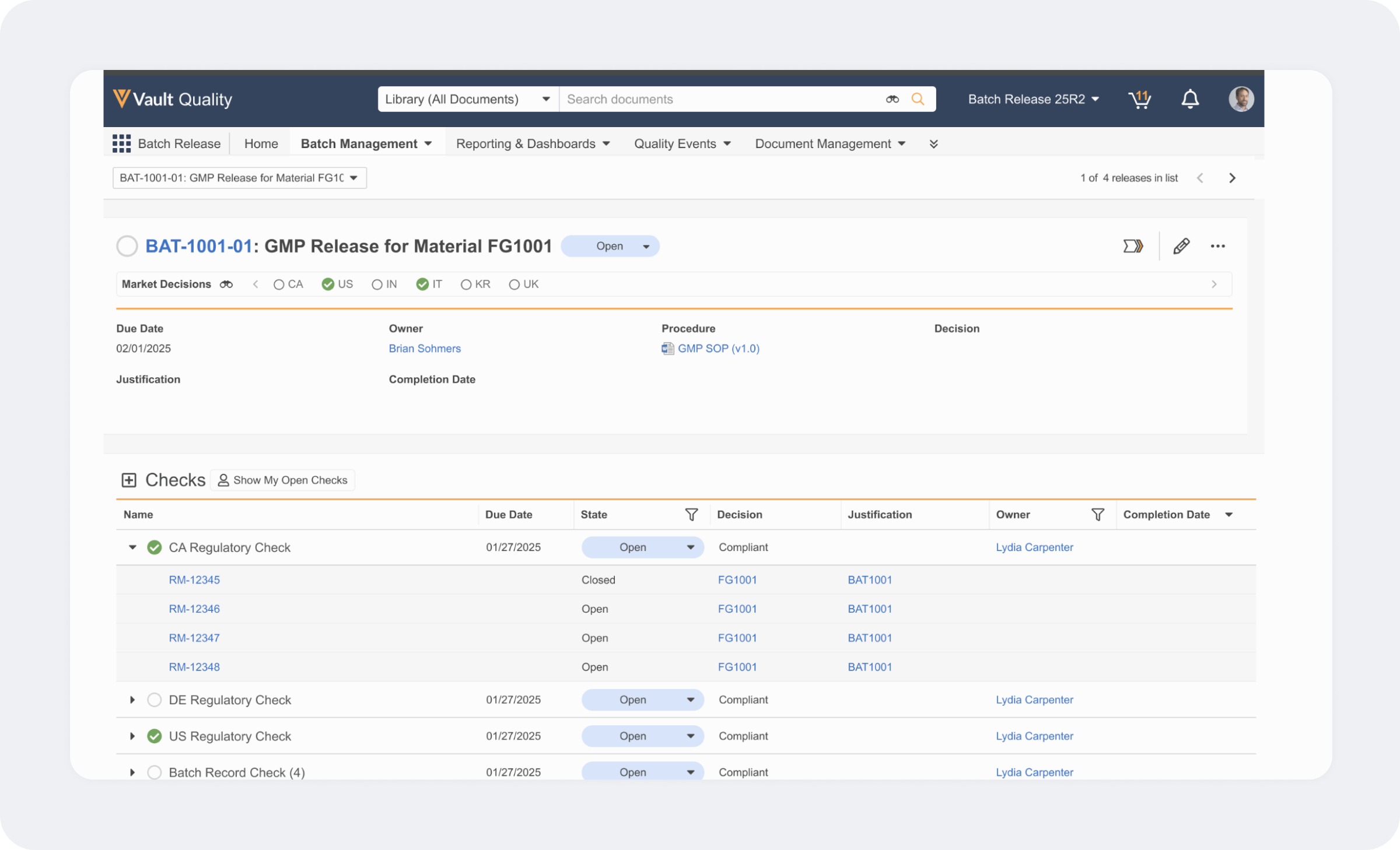Blog
From Excess Caution to True Jurisdictional Control: Shifting Gears on Market Shipping
Nov 04, 2025 | Mike Edwards
Nov 04, 2025 | Mike Edwards
- Jurisdictional control becomes complex when shipping many products to different markets
- Automated monitoring of market registrations, changes, and real-time disposition status indicators will help
The complexity of jurisdictional control leads to batches that would otherwise be released remaining on the shelf.
Because jurisdictional rules layer approvals, even small changes can result in big headaches. For companies shipping many products to multiple jurisdictions, a relatively minor change upstream — say, a new testing site or product formulation, or evolving regulation — can cause the disposition process to splinter into hundreds of potential paths.
Jurisdictional control was traditionally managed through integrations between different systems, each responsible for a discrete aspect of the batch disposition process. This places a high burden of effort on teams, particularly when many suppliers, materials, and markets are involved. Fragmented data and highly manual processes across production, quality, and regulatory functions also create bottlenecks while coordinating activities. Connecting the quality ecosystem with regulatory would improve how change controls are managed and support review by exception.
Abundant caution entails costs
As market ship approvals are time-bound, any changes to raw or intermediate materials or finished goods can increase complexity. Disposition owners and Qualified Persons (QPs) are responsible for managing the interplay between regulatory approvals in every jurisdiction, change control procedures, and the so-called can ship / may ship / must ship framework (and its variations).
Once a change occurs, decision-makers need to assess supply chains and identify links between raw materials, finished goods, and where they were produced. Two scenarios can trigger this. First, the organization switches product materials: after a specified ‘must ship’ date, products made from the old pre-change material will no longer be accepted. If supply chains are not ready by this cutoff, companies might build products that are not allowed in the market.
Another scenario emerges while changing suppliers. During the changeover from supplier A to supplier B, produced batches that are already qualified for a given market cannot go out until the ‘may ship’ date. Goods could accidentally be sent to a market that isn’t able to receive them.
Companies unable to see the full story for each batch and market in one place usually err on the side of caution and choose not to ship to avoid making mistakes. Operational delays ensue. Different functions (such as regulatory, operations, IT, quality, and supply chain) may pitch in to minimize inventory carry, but manually locating the necessary documents for every batch strains resources.
Even when the market ship decision is clear, compliance risks remain. For example, the disposition owner or QP might lack an audit trail indicating due diligence was completed and batch release validated as part of the Good Manufacturing Practice (GMP) process.
All of this adds inventory costs and lengthens time to market. Extrapolating over 100+ market ship countries, large product portfolios, and dozens of suppliers, the impact of these upstream changes can be significant even for well-resourced organizations.
‘Review by exception’ becomes a reality
Centralizing all relevant content and data helps disposition owners and QPs prove compliance for each batch. They can do this by tracking deviations and change controls in Veeva QMS, viewing certificates and reports (e.g., from manufacturing partners) in QualityDocs, and reports from testing labs in LIMS [Figure 1].
Connectivity with registration data in RIM helps companies move forward after upstream changes: decision-makers can pull in and assess market approvals through change controls. Application programming interfaces (APIs) bring information from other systems that are not part of the quality ecosystem. This includes labeling and artwork, warehouse management, and MES systems, as well as documents in ERP relating to materials, batches, and genealogy.
Figure 1: Centralizing the user experience leads to simpler batch release

Source: Veeva Systems
Once the quality decision is made, it is sent to the ERP for processing. A market release decision swiftly follows. Disposition owners and QPs can see restrictions at a glance before moving forward a batch, facilitating ‘review by exception’.
Disposition owners need clear, simple instructions confirming each batch is compliant for shipment. In the future, automation will further reduce friction when verifying regulatory compliance. Linking change controls with country-specific approval statuses allows the system to evaluate releasability, provide guidance on regulatory restrictions, and reflect new information in real time, such as registration changes. A green check mark for ‘go’ and a blank for ‘no’ for each market will become the standard, replacing phone calls and emails taking place today [Figure 2].
Figure 2: Veeva Batch Release will soon automate regulatory restrictions

Source: Veeva Systems
Real-time warnings will also soon be a reality, indicating to disposition owners and QPs that they should not move ahead with shipping. Because all markets are visible within a change control, the system can prevent batches linked to a market that has an issue from moving forward.
Finally, automated shipping will help companies managing dozens of jurisdictions. The system will be able to specify on a per batch basis whether each market is released. Over time, technology will address market restrictions further upstream, such as during ordering and supply. Instead of building batches that won’t be used, teams will see issues ahead of time and divert to other markets.
Increased control, less work
Automation can help surface all the content and data needed to understand batch status and market restrictions for true jurisdictional control. This way, batches won’t sit on the shelf for a moment longer than they need to.
Learn how Veeva Batch Release helps organizations master jurisdictional control.